

Fishing a waggler floatA waggler float, strictly speaking, is the term given to any float which is attached only at the bottom to the line. For this reason it comes in a variety of shapes, sizes and materials.
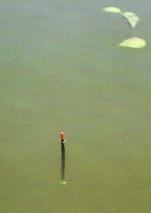
There is no mystery to a waggler and once you have mastered the it, you have at your disposal an extremely versatile technique and also one that produces bites, if not fish, when all other techniques fail. Are There Different Types?They come in two different types of waggler float in use today - straight or bodied. Also these two types can come both with or without inserts.
A straight without an insert 
A straight with an insert. 
A bodied without an insert. 
A bodied with an insert Making The Waggler float PartsThe different parts are usually made up from -
Some waggler floats are made entirely from one piece of balsa, a lot of these are home made, to suit local waters that the fisherman has fished for years. Why Use a Waggler float?As with all types of fishing you want to get the bait to where the fish are and keep it there. With float fishing there are several conditions which may make this difficult to do -
Firstly, a float that is attached by its bottom, with the bulk of the shot around its base, acts like a dart as it flies through the air. It is possible to cast it a long way with great accuracy. When fishing at long range, try casting out to where you want to fish. Then put an elastic band on the spool. This will enable you to cast to the same spot every time, thus ensuring that the hookbait is over the feed area. Remember to "feather the line" when casting. What Is Feathering The Line?Feathering the line is the art of controlling the float and terminal gear while casting to ensure they land correctly in the water and don't get tangled up, there is nothing more fustrating than to cast out and after waiting for a bait, to reel in only to find the line all tangled up around the float To feather the line the fisherman has to -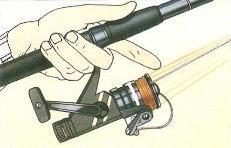
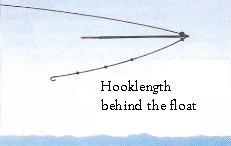
Cast as usual releasing the line from under your forefinger to send the float out towards a target area slightly beyond the feed area. Your forefinger is kept close to the spool�s lip, ready to start feathering. At this stage the hooklength lags behind the float. 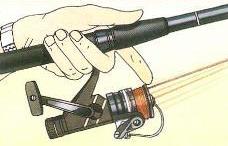
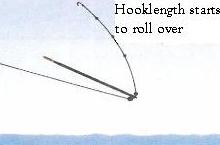
The next thing to do is - as the float approaches the target area, gently slow the line, do this by touching the spool�s lip with your fingertip. The hooklength will begin to roll over and precede the float. Note that only through practice will you know the right amount of pressure to apply. 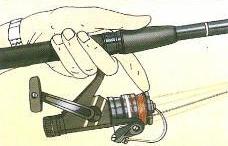
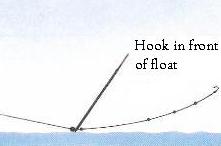
Now slightly increase the pressure to land the float spot on target (just beyond the feed area) with minimum disturbance. The terminal rig should land in a straight line with hook in front of float. Wind the float backwards over your feed, sinking the line. Going back to the second point made above - the wind making it hard to keep the float in place, because the line passes through the bottom of the float, you can keep the line entirely beneath the water�s surface, away from the wind. To help the line sink, soak it with a solution of fuller�s earth and detergent. However, there are times when fishing medium and fast-flowing rivers, that you need to hold a bait back. If you use a waggler float it will dive under each time you pull on the float. In this case a float attached top and bottom would be better � a stick float, would be ideal. Which Rig To Use?Some of the things you have to take into account before setting up your rig are - do you want to catch on the drop or do you want to get to the bottow quick, the other thing to take into account is the speed of the water.With that taken into account here are 4 waggler rigs to get you going. 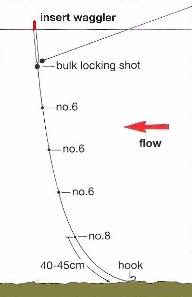
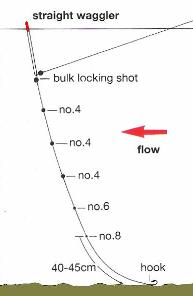
The 2 rigs above are for fast flowing water. The difference in the 2 are that the one on the left will drop the bait slowly through the water giving you the chance of getting fish in mid-water. Whereas the one on the right will drop the bait quickly through the water to get to the bottom. 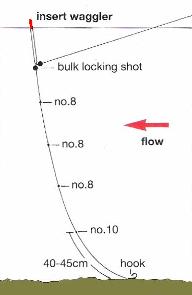
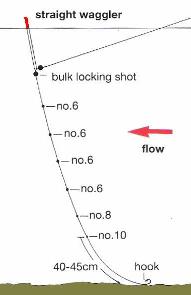
The 2 rigs above are for slow running or still water. As with the first 2 rigs the one on the left will drop slowly through the water and the one on the right will drop quickly through the water. 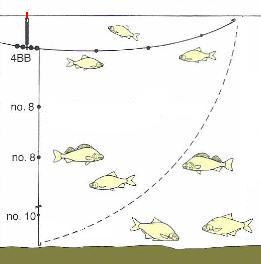 The rig on the left is an �on the drop rig�, it will catch fish at all levels. The bulk of the shot goes round the base of the float. Then the rest of the shot is spread out evenly down the line, causing the line to sink in an arc. Any fish taking the bait on the drop will cause the insert to lift or cause a slight delay in its settling. This is the same set up as the 2 on the left above.
The rig on the left is an �on the drop rig�, it will catch fish at all levels. The bulk of the shot goes round the base of the float. Then the rest of the shot is spread out evenly down the line, causing the line to sink in an arc. Any fish taking the bait on the drop will cause the insert to lift or cause a slight delay in its settling. This is the same set up as the 2 on the left above.
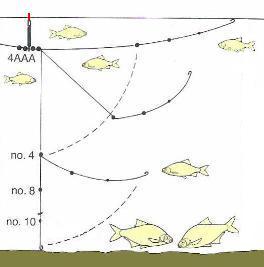
The waggler rig on the right is an �on the bottom rig� The use of the heavier no.4 shot makes the hook and bait sink faster, getting through the mid-water fish to the better fish on the bottom. When feathering on the cast, the no.4 shot brings the hooklength over in a nice arc, preventing tangles. Didn't Find What You Were Looking For?
Custom Search
Back to Waggler Float Top Back to Fishing Rigs/A> Back to Home |






















